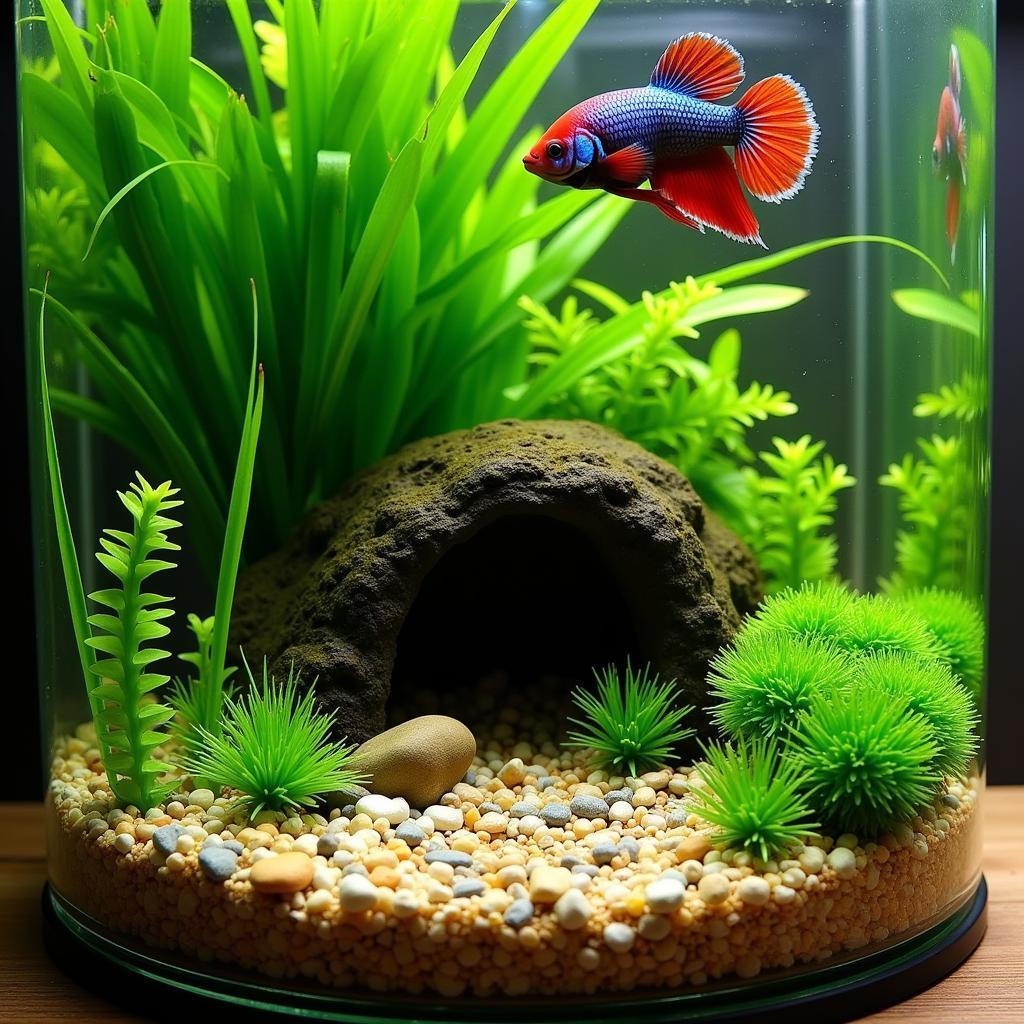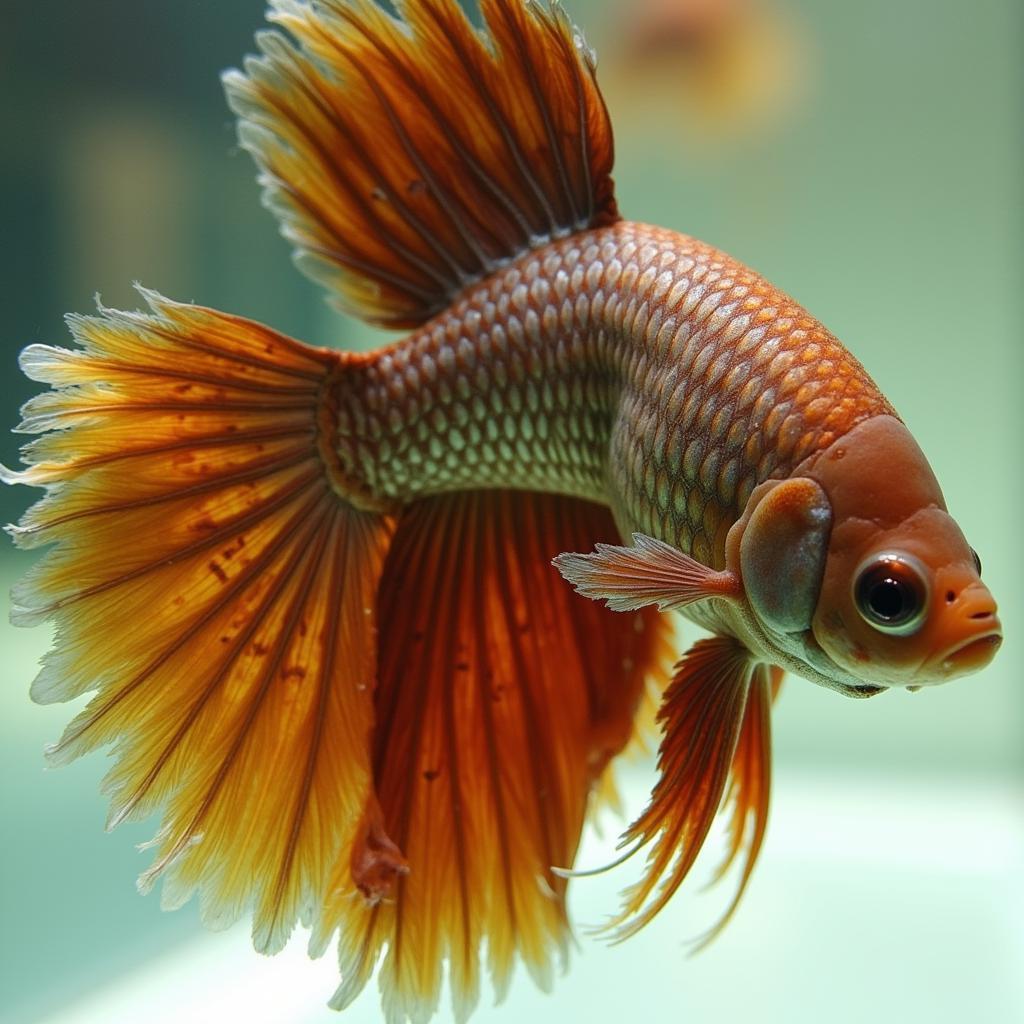Beta fish, also known as Siamese fighting fish, are captivating creatures that add a splash of color and personality to any space. Their vibrant hues and flowing fins make them a popular choice for aquarium enthusiasts. Proper beta fish care, however, is essential for their health and longevity. This guide will delve into everything you need to know to keep your betta thriving.
Understanding Your Betta’s Needs
Betta fish are tropical freshwater fish originating from Southeast Asia. They thrive in shallow, still waters like rice paddies and slow-moving streams. This natural habitat informs their specific care requirements. Providing an environment that mimics these conditions is crucial for their well-being. This includes maintaining the correct water temperature, providing appropriate filtration, and offering a balanced diet. Overlooking these factors can lead to stress, illness, and a shortened lifespan.
Water Quality and Temperature
Maintaining pristine water quality is paramount for beta fish care. Regular water changes are essential to remove waste products and maintain a healthy environment. Aim for 25% water changes every week or 50% every two weeks. Use a water conditioner to neutralize chlorine and chloramine, which are harmful to fish. The ideal water temperature for bettas is between 78-80°F (25.5-26.5°C). Use a reliable aquarium thermometer to monitor the temperature consistently and a heater to maintain it within the optimal range.
Tank Size and Environment
Despite their small size, bettas need adequate space to swim and explore. A minimum tank size of 5 gallons is recommended for a single betta. Smaller tanks can restrict their movement and lead to stress. Furnish the tank with plants, caves, and other decorations to provide hiding places and enrichment. Live plants are particularly beneficial as they help maintain water quality and create a more natural environment. Avoid sharp decorations that could damage their delicate fins.
 A 5-gallon betta tank setup
A 5-gallon betta tank setup
Feeding Your Betta
Betta fish are carnivores and require a diet rich in protein. High-quality betta pellets or flakes should form the staple of their diet. Supplement this with occasional treats like bloodworms, brine shrimp, or daphnia. Overfeeding can lead to digestive issues and water pollution, so feed your betta small portions twice a day. Remove any uneaten food after a few minutes to prevent it from decaying in the tank.
Common Betta Fish Health Issues
Even with the best care, bettas can sometimes experience health problems. Recognizing the signs of illness early is crucial for effective treatment.
Fin Rot and Ich
Fin rot is a bacterial infection that causes the fins to fray and deteriorate. Ich, also known as white spot disease, is a parasitic infection characterized by small white spots on the body and fins. Both conditions can be treated with aquarium medications available at pet stores. Follow the instructions carefully and ensure proper water quality to prevent recurrence.
Swim Bladder Disease
Swim bladder disease affects a fish’s ability to control its buoyancy. Affected fish may float at the surface, sink to the bottom, or swim erratically. This can be caused by various factors, including constipation, infection, or injury. Consult a veterinarian or aquatic specialist for diagnosis and treatment.
 Betta fish with fin rot
Betta fish with fin rot
Setting Up Your Betta Tank: A Step-by-Step Guide
- Choose the right tank: Opt for a 5-gallon or larger tank.
- Install a filter and heater: Select a gentle filter and a heater suitable for the tank size.
- Add substrate: Use gravel or sand as substrate.
- Decorate the tank: Include plants, caves, and other decorations.
- Cycle the tank: Allow the beneficial bacteria to establish before adding your betta.
- Acclimate your betta: Gradually introduce your betta to the new tank water.
Dr. Emily Carter, a renowned aquatic veterinarian, emphasizes the importance of proper acclimation: “Introducing a betta to a new tank too quickly can shock their system. Slow acclimation is vital for their well-being.”
Conclusion
Beta fish care requires attention to detail and a commitment to providing a suitable environment. By following the guidelines in this ultimate guide, you can ensure your betta lives a long, healthy, and vibrant life. Remember that a happy betta is a healthy betta!
FAQs
- How often should I change the water in my betta tank? Aim for 25% water changes weekly or 50% bi-weekly.
- What is the ideal tank size for a betta? A minimum of 5 gallons is recommended.
- What should I feed my betta? High-quality betta pellets or flakes supplemented with occasional treats.
- How do I treat fin rot? Use aquarium medications specifically designed for fin rot.
- Can I keep two bettas together? Male bettas should be kept alone, but females can sometimes coexist in a sorority tank.
John Smith, an experienced fish keeper, adds, “Observing your betta’s behavior is key. Any changes in appetite, activity, or appearance could indicate a problem.”
Have more questions about care plan for hypertension? Check out our article here: care plan for hypertension
Need more information on maintaining a healthy aquarium? See our articles on water quality and fish diseases.
For any further assistance, please contact us via WhatsApp: +1(641)206-8880, Email: [email protected] or visit us at 276 Reock St, City of Orange, NJ 07050, United States. Our customer support team is available 24/7.


